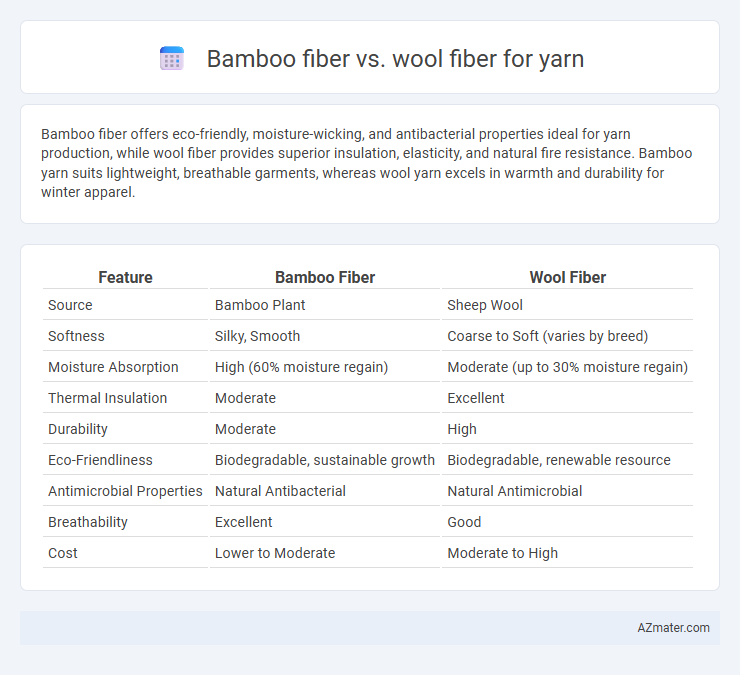Bamboo fiber offers eco-friendly, moisture-wicking, and antibacterial properties ideal for yarn production, while wool fiber provides superior insulation, elasticity, and natural fire resistance. Bamboo yarn suits lightweight, breathable garments, whereas wool yarn excels in warmth and durability for winter apparel.
Table of Comparison
| Feature | Bamboo Fiber | Wool Fiber |
|---|---|---|
| Source | Bamboo Plant | Sheep Wool |
| Softness | Silky, Smooth | Coarse to Soft (varies by breed) |
| Moisture Absorption | High (60% moisture regain) | Moderate (up to 30% moisture regain) |
| Thermal Insulation | Moderate | Excellent |
| Durability | Moderate | High |
| Eco-Friendliness | Biodegradable, sustainable growth | Biodegradable, renewable resource |
| Antimicrobial Properties | Natural Antibacterial | Natural Antimicrobial |
| Breathability | Excellent | Good |
| Cost | Lower to Moderate | Moderate to High |
Introduction to Bamboo and Wool Fibers
Bamboo fiber, derived from the pulp of bamboo grass, is renowned for its natural antibacterial properties, breathability, and eco-friendly cultivation, making it a sustainable alternative in yarn production. Wool fiber, sourced from the fleece of sheep, offers exceptional thermal insulation, elasticity, and moisture-wicking capabilities, which have made it a traditional staple in textile manufacturing. Both fibers exhibit unique qualities suited for different types of yarn, influencing softness, durability, and environmental impact in fabric creation.
Fiber Source and Sustainability
Bamboo fiber originates from the fast-growing bamboo plant, known for its minimal water and pesticide requirements, making it a highly sustainable choice for yarn production. Wool fiber is derived from sheep fleece, a renewable resource but often associated with environmental concerns such as land use, methane emissions, and animal welfare. Bamboo's eco-friendly cultivation paired with its biodegradability offers a greener alternative compared to traditional wool fiber in sustainable yarn manufacturing.
Texture and Feel Comparison
Bamboo fiber yarn offers a smooth, silky texture with a cool, soft feel, making it ideal for sensitive skin and breathable fabrics. Wool fiber yarn features a natural crimp that provides warmth, elasticity, and a coarser, slightly scratchy texture depending on the type of wool. Bamboo excels in moisture-wicking and softness, while wool is favored for insulation and durability in colder climates.
Moisture Absorption and Breathability
Bamboo fiber exhibits superior moisture absorption compared to wool fiber, with a moisture regain rate of approximately 11.5% versus wool's average of 13-18%, yet bamboo feels drier due to its high breathability. Bamboo yarn promotes enhanced airflow, making fabrics cooler and more comfortable in humid conditions, while wool's natural crimp traps air for better insulation and moderate breathability. These properties make bamboo yarn ideal for moisture-wicking summer garments, whereas wool yarn excels in moisture management and insulation for colder environments.
Thermal Insulation Properties
Bamboo fiber exhibits excellent thermal insulation properties due to its breathable and moisture-wicking nature, making it ideal for regulating body temperature in various climates. Wool fiber is renowned for superior warmth retention and insulating capability, trapping air effectively to provide consistent heat in cold conditions. Comparing the two, wool offers better insulation for extreme cold, while bamboo fiber provides balanced thermal comfort suitable for moderate temperatures and active wear.
Durability and Longevity
Bamboo fiber yarn exhibits moderate durability, offering natural antibacterial and moisture-wicking properties but tends to weaken with frequent washing compared to wool fiber. Wool fiber yarn provides exceptional durability and longevity due to its resilient protein structure, elasticity, and natural resistance to wear and tear. Choosing wool fiber ensures longer-lasting yarn suitable for heavy-use textiles, while bamboo fiber suits softer, eco-friendly applications with moderate durability.
Allergies and Skin Sensitivity
Bamboo fiber is naturally hypoallergenic and antimicrobial, making it ideal for individuals with sensitive skin or allergies, as it reduces the risk of irritation and allergic reactions. Wool fiber, while warm and durable, contains lanolin, which can trigger allergic responses and discomfort in sensitive skin types. Bamboo yarn offers a softer, smoother texture that is less abrasive compared to wool, enhancing comfort for allergy-prone and sensitive skin.
Dyeing and Color Retention
Bamboo fiber exhibits superior dye absorption due to its smooth surface and hygroscopic properties, resulting in vibrant and long-lasting colors in yarn applications. Wool fiber, with its complex protein structure and scales, often requires specialized mordants to achieve consistent dye uptake and color fastness. Bamboo yarns typically retain color more evenly over time, while wool yarns may experience color fading faster under exposure to sunlight and repeated washing.
Eco-Friendliness and Environmental Impact
Bamboo fiber is highly eco-friendly due to its rapid growth rate, minimal pesticide use, and biodegradability, making it a sustainable choice for yarn production. Wool fiber, while natural and biodegradable, involves significant environmental impact from sheep farming, including methane emissions and land degradation. Bamboo's lower water consumption and faster renewability make it a more environmentally sustainable option compared to traditional wool yarn.
Best Uses in Yarn Projects
Bamboo fiber excels in yarn projects requiring softness, breathability, and antibacterial properties, ideal for lightweight garments, baby clothes, and summer accessories. Wool fiber offers superior warmth, elasticity, and moisture-wicking abilities, making it the best choice for winter wear, sweaters, socks, and durable outerwear. Combining bamboo and wool fibers in yarn can optimize comfort and functionality for a wide range of textile applications.

Infographic: Bamboo fiber vs Wool fiber for Yarn
 azmater.com
azmater.com